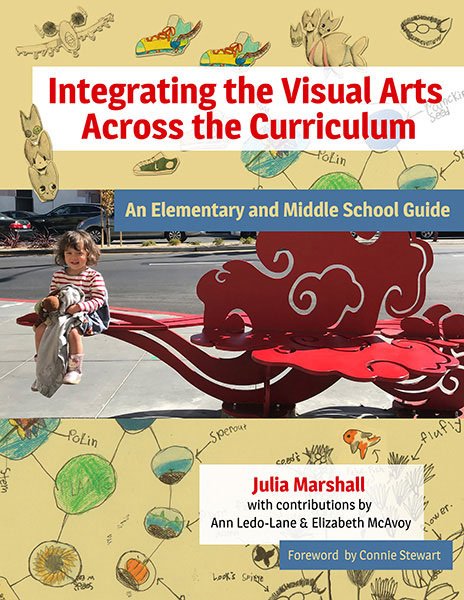Professors: Request an Exam Copy
Print copies available for US orders only. For orders outside the US, see our international distributors.
With: Ann Ledo-Lane, Elizabeth McAvoy
Foreword by: Connie Stewart
Publication Date: August 30, 2019
Pages: 144

“If you long for an arts classroom that connects students to the astonishingly interesting world they live in and want some helpful guidance on how to do it, this is the book for you!” —From the Foreword by Connie Stewart, University of Northern Colorado
With lots of examples and color images, this resource is both a foundational text and a practical guidebook for bringing contemporary art into elementary and middle school classrooms as a way to make learning joyful and meaningful for all learners.
Marshall shows how asking questions and posing problems spark curiosity and encourage learners to think deeply and make meaningful connections across the curriculum. At the center of this approach is creativity, with contemporary visual art as its inspiration. The text covers methods of creative inquiry-based learning, art and how it connects to the “big ideas” addressed by academic domains, flexible structures teachers can use for curriculum development, creative teaching strategies using contemporary art, and models of art-based inquiry curriculum.
Book Features:
Julia Marshall is professor emeritus of art education at San Francisco State University and coauthor of Art Centered Learning Across the Curriculum. Contributors: Ann Ledo-Lane is director of arts programming at the Creative Arts Charter School in San Francisco. Elizabeth McAvoy is a middle school visual arts teacher in San Francisco, California.
“If you long for an arts classroom that connects students to the astonishingly interesting world they live in and want some helpful guidance on how to do it, this is the book for you!”
—From the Foreword by Connie Stewart, University of Northern Colorado
“Marshall’s examples from contemporary artists are targeted and immediately helpful to teachers across the curriculum. Grounded in theory and practice, she describes creative inquiries that students use to move into ever-deepening understanding. I wish I’d had this book when teaching PK–12 in general classrooms!”
—Lois Hetland, Massachusetts College of Art and Design, and coauthor of Studio Thinking from the Start
"This book is an inspiring resource to prepare students for the creative future. As a practical guide, it supports teachers in connecting learning across disciplines to fuel creative and critical thinking, and the use of examples from practitioners supports the theories. I highly recommend this book for teachers, schools, and district leaders."
—Lorinda Rice, curriculum specialist for visual art, Lincoln Public Schools, Nebraska
Contents
Foreword by Connie Stewart ix
Preface xi
Acknowledgments xii
PART I: Foundations of Creative Inquiry
1 Learning Through Creative Art-Based Inquiry 3
Creative Art-Based Inquiry Learning 3
The First-Grade Community Inquiry 7
Other Key Aspects of the Creative Inquiry Approach 11
2 Curriculum Integration Through Creative Inquiry 16
The Disciplines: Overlaps, Intersections, and Hybrids 16
Curriculum Integration 17
Art as an Integrative Discipline 19
Art and Integrated Creative Inquiry 23
PART II: The Academic Disciplines and Related Art
3 The Natural Sciences: Understanding the Natural World 29
Four Dimensions of the Natural Sciences 29
Comparing Science and Art 32
Examples of Art That Explores Crosscutting Concepts 33
Examples of Art Inspired by Science 36
Integrating Science and Art in the Classroom 38
4 Mathematics: Logic and Abstraction Meet Application and Aesthetics 40
Four Dimensions of Mathematics 40
Intersection of Math and Art 43
Examples of Art Inspired by Concepts in Math 44
Integrating Math and Art in the Classroom 45
5 Social Studies: Understanding Ourselves and Others 49
Four Dimensions of Social Studies 49
Intersection of Social Studies and Art 52
Examples of Art Exploring Concepts in Social Studies 53
Integrating Social Studies and Art in the Classroom 58
6 Language Arts: Creative Writing and Storytelling 59
Four Dimensions of Creative Writing 59
Kinds of Stories 62
Art That Tells Stories 63
Literacy Through Visual Art 66
PART III: Art-Based Strategies for Creative Inquiry
7 Learning Strategies for Creative Inquiry 71
Kinds of Creative Thinking 71
Creative Strategies in Contemporary Art 72
Strategies for Thinking, Inquiry, and Learning 81
The Research Workbook 83
8 Frameworks and Strategies for Curriculum and Pedagogy 93
Utilizing the Project Zero Frameworks 93
Creative Curriculum Development: Making Trails 98
9 Inquiry Trails: Examples of Creative Inquiry-Based Art Integration 103
Trail #1: Patterns and Mathematics in Natural Forms 103
Trail #2: Animal Structures and Architecture 106
Trail #3: An Imaginary Island World 108
Trail #4: Medicinal Plants to Treat a Social Issue or Problem 111
Trail #5: Me and My World 112
Conclusion 117
Credits 119
References 122
Index 125
Biographical Notes 131
Professors: Request an Exam Copy
Print copies available for US orders only. For orders outside the US, see our international distributors.